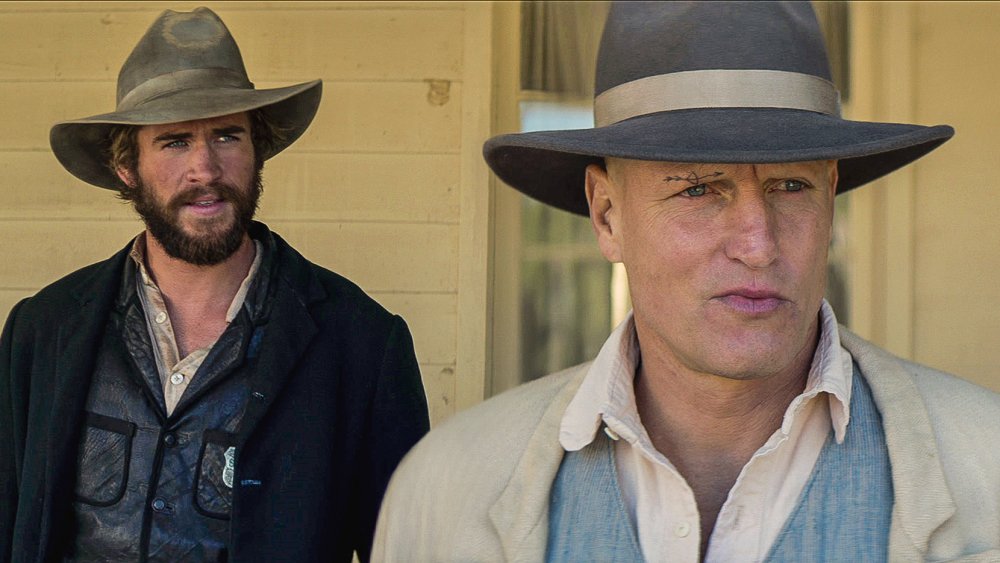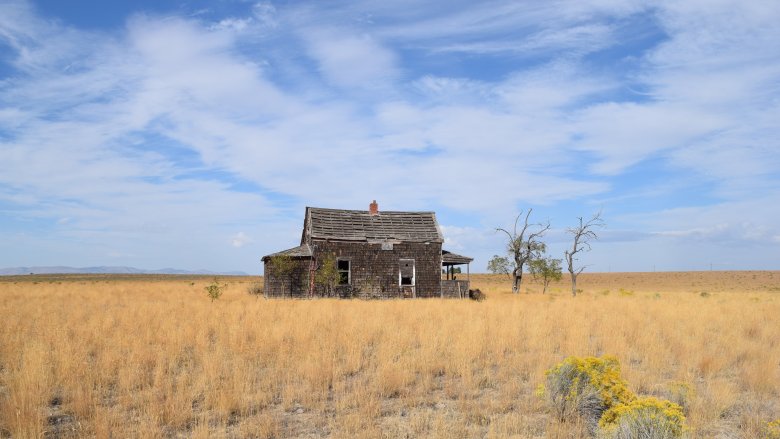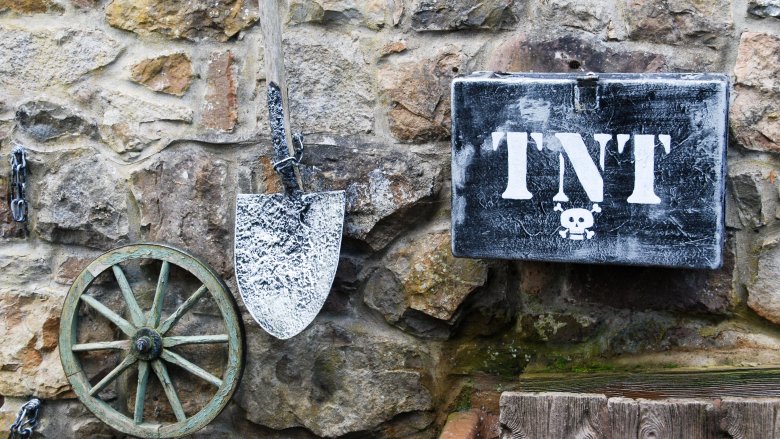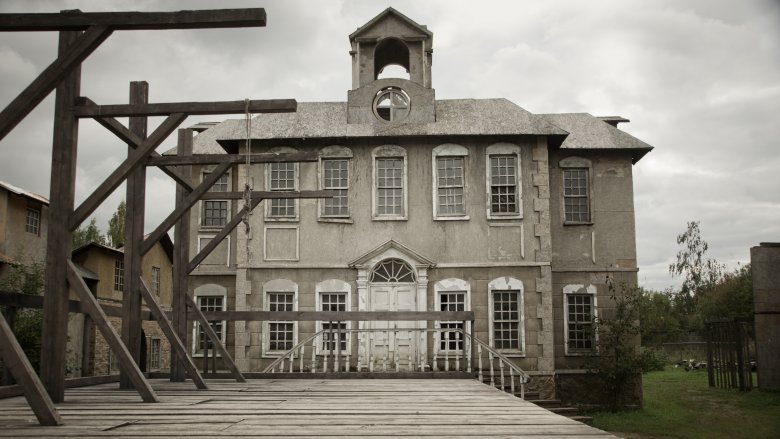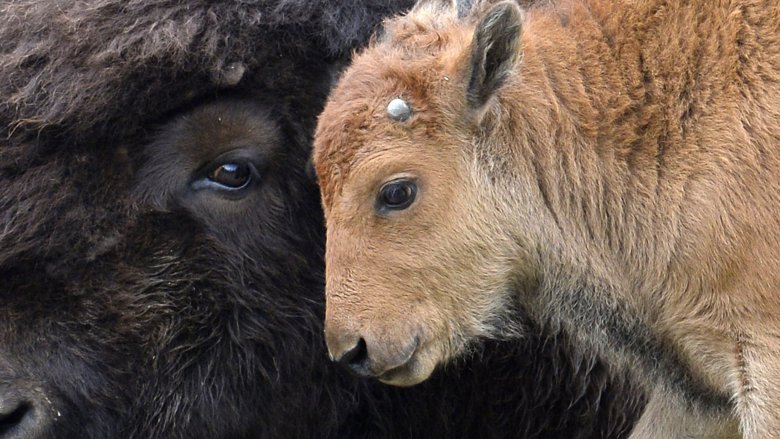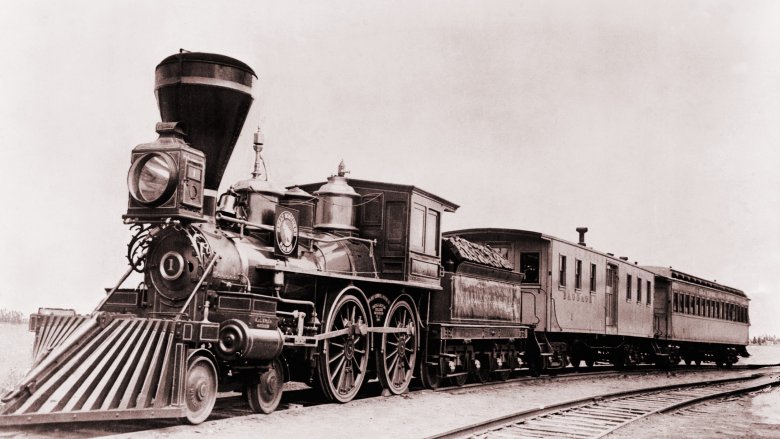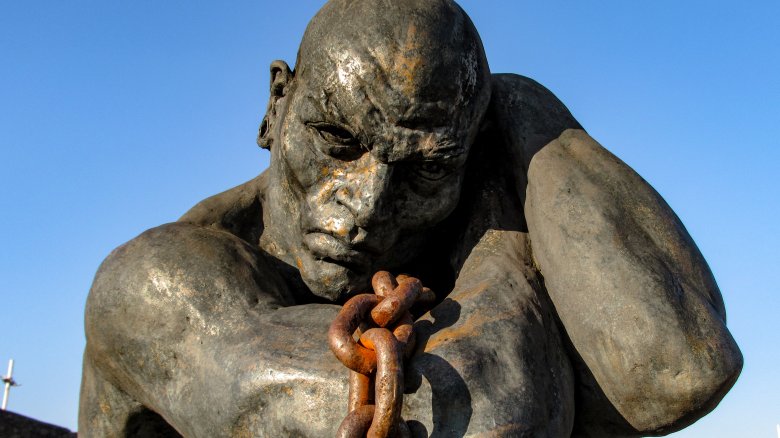Messed Up Things That Actually Happened In The Old West
There's a certain appeal to the idea of living in the Old West. The freedom, the open range, the completely unregulated use of swearing in the workplace. Sure, there are negatives, but even if you think you could survive a lack of indoor plumbing and options for takeout, there were plenty of other messed up things you'd have to deal with.
Helena duels
Remember when Woody Harrelson and Liam "Not Thor" Hemsworth starred in the 2016 Western The Duel? In case you didn't see it, Hemsworth is investigating some murders and a cult-like town led by Harrelson, and the titular duel involves two men facing off in a pretty non-traditional way. Their left hands are tied together, they're each given a short-bladed knife, and then they hack away at each other until blood loss takes one man down.
Pretty brutal, right? That particular style of dueling was picked up out of the pages of history. It's a Helena duel, after the Texas town it started in. According to Texas Monthly, the town was pronounced HELL-ena because during the 1860s, it attracted all kinds of tough characters. The duel ensured the people of the town would have plenty of time to cheer and wager on a winner, since the short blades of the knives guaranteed there would be no instantaneous kill shot. It might be extreme, but hey, it's one way to deal with trolls.
The Bloody Benders
In 1870, the Bender family settled in Kansas along the Great Osage Trail. It was a great place for Ma and Pa Bender, along with daughter Kate and son John, to set up their little inn and store. Travelers could stay, pick up some supplies, get their fortune told by Kate, and possibly die.
It wouldn't come out until later that Ma had been married a few times to men who had a tendency to die from head trauma, that Kate was one of her 12 children, and that John was possibly Kate's husband, not her brother. Uh ... what?
It wasn't uncommon for people to head West only to drop off the face of the earth, so it wasn't until the 1872 disappearance of George Loncher and his baby daughter that things started unraveling. Dr. William York set out to find them, and when he disappeared, too, his very important brothers wanted to know what the heck was going on. By the time they followed the trail to Labette County and got wind of how creepy the Benders were, they'd high-tailed it out of town and left behind a house with a blood-covered cellar. When neighbors recalled that the Benders always seemed to be plowing no matter the season, volunteers started digging. They found 10 bodies, and the Benders were ultimately linked to 21 murders. Mental Floss says there were plenty of stories, but no closure — none of the Benders were ever heard from again.
The Watson-Averell lynching
In the final days of July 1889, a man and a woman were hanged in Wyoming, just spittin' distance from the Sweetwater River. The newspapers went a bit mad in reporting, and according to the Casper Star Tribune, the sensationalized stories were filled with tales of vigilante cattlemen who had protected their herds from the dastardly cattle rustlers. The two who had been hanged were James Averell and Ella Watson, and it wasn't until the 1990s that a few historians did some digging into what actually happened (via WyoHistory).
In the 1880s, there was a fortune to be made in cattle. Tycoons grazed mind-numbingly huge herds across government land, but the bottom fell out of the market. There were cattle rustlers, sure, but there were also small-scale settlers who were applying for and getting small parcels of land they'd fence off and use for their own operations. Watson and Averell both had land claims, right in the middle of the grazing lands of Albert Bothwell. Bothwell wanted to buy the claims, but Watson and Averell refused. It didn't sit well, and after months of talking, Bothwell and his cronies abducted the pair from their homesteads, headed off to the river, and strung them both up.
There were witnesses and the lynch party was named, but by the time the case went to court the witnesses had conveniently disappeared. The case was dropped, leaving the cattle tycoon to get away with murder as well as some serious slander.
The Chinese massacre at Deep Creek
When author R. Gregory Nokes (via The Oregonian) started research for a book, he found there was nothing to mark the location of one of the Old West's most horrible hate crimes. It happened along the Snake River on May 25, 1887, and it was the brutal massacre of 30-ish Chinese gold miners. That's how little is known about what happened there — we don't have a definite number of people who were killed, and the 11 names we do know are in the English alphabet, leaving even their identities a mystery.
We do know the miners were killed for about $5,000 worth of gold that probably ended up entirely in the possession of one of the killers, the 21-year-old J.T. Canfield. The group was mostly ranch hands and horse thieves, along with a 15-year-old school boy. Nokes and his fellow researchers know it wasn't just about the money, as the bodies were savagely mutilated with axes before being floated down-river.
The murder didn't go completely unnoticed, but it did go unpunished. Six men went on trial, if you'd care to call it that. In spite of one man turning state's evidence, all were found innocent. Canfield was never tried at all, but it seems the gold went to some use — his tombstone is the biggest in the cemetery of Glenns Ferry, Idaho.
Botched hangings
Hanging someone is more complicated than you might think, and while you can Google it (and then clear your internet history, because seriously), trust us when we say there are a lot of considerations like weight, how you want the person to ultimately die, and even the strength and tension in the rope. The New York Times says a reliable formula for determining drop wasn't published until 1913, so there were a lot of horribly botched hangings in the decades before that.
The hanging of Tom Horn was retold in The Saga of Tom Horn (via Eyewitness to History), and they say it's often counted as one of the moments the Old West died. Horn worked as an enforcer for the massive cattle barons who grazed their herds across open government land, until 1901 when he accidentally killed the 14-year-old son of his actual target. He confessed and was sentenced to hang, using a method that relied on the condemned man's weight to empty a bucket and trigger the mechanism. The trap door opened but he didn't fall far enough. He was knocked unconscious by the knot, and it took him 17 minutes to die. The opposite happened to "Black Jack" Tom Ketchum, and it's no wonder Executed Today says he was the last man to hang for train robbery. He fell too far, ending his life not at the end of a rope, but when he was completely and cleanly decapitated.
Wild bison were completely destroyed
Just try to imagine the Old West, with no billboards in the way of massive herds of bison. That started to change in earnest on May 10, 1869. If there's anything to be said for Americans, it's when they ruin something, they ruin it good.
That's the date the Pacific Railroad was completed, and it opened up the West to a whole different sort of person — those who were adventurous enough to go but still wanted a comfortable chair to sit in on the way. According to the Smithsonian, those people also ended tens of millions of bison.
Railroads would advertise hunting excursions in which paying customers could climb atop train cars to shoot the bison running alongside the tracks. Hundreds of thousands of bison corpses were left to rot where they fell, and one man — Orlando "Brick" Bond — is credited with killing thousands himself. (The only consolation there is that he supposedly went deaf in one ear from firing his rifle.) Just as bad, the U.S. military encouraged these slaughters, hoping it would deprive Native American tribes of their food supply. They did such a good job that there were only a few hundred animals left by the 1900s, leaving a ruined species that still hasn't recovered. PBS says today's bison have been so completely hybridized that less than 2 percent are the purebreds that once roamed the plains. Thanks, progress.
Train smash
William Crush (yes, that was really his name) was a railway man who had an idea of dubious brilliance in 1894. The idea was to create such a massive public spectacle it would secure the future of the Missouri-Kansas-Texas Railroad Company, more popularly called the Katy. Crush decided to set up the temporary city of Crush, featuring a carnival and the main attraction, two 35-ton train engines to be smashed together.
This was a huge deal at the time. According to newspaper accounts assembled by the Smithsonian, conversation about everything else took a back seat to the train smash. When the big day finally came, Crush became the second-largest city in the state as around 40,000 people came flooding in. The epic event went off somewhat as planned, but if you were wondering whether or not boiler-driven steam trains would explode on impact ... they do.
The trains were each going about 50 mph when they hit, and according to reports, there was a heartbeat of silence before they exploded in a shower of hot debris. At least two people were killed and no one's sure how many were injured. One survivor, J.C. Deane, got $10,000 and a lifetime railway pass for his lost eye. Crush was fired, then immediately re-hired when they realized how popular he'd made them. You know, among people who hadn't lost eyeballs.
Whiskey was pretty different
Sure, you probably think you'd have no problem sidling up to the bar and knocking back a shot of the saloon's finest sippin' whiskey, but truth is you'd probably throw up into your glass before you finished the drink. Whiskey had names like "Forty Rods" because that's how far you'd get before you hit the ground. That's apparently milder than "Taos Lightning," which would immediately drop a man.
The Sierra Sun says saloons typically had an impressive array of all kinds of alcoholic beverages on offer, from beer to wine, but let's talk about what that liquor was made out of. "Tarantula Juice" was made from strychnine, and yes, that's a literal poison. Historian C.W. Bayer says it got its name from what happens to a person when the whiskey and the strychnine started to wear off — it made you feel like you had tarantulas crawling over you, which isn't how you want a party to end. Oh — and you typically ordered two, one to start and one to help you deal with the symptoms of the first.
Other liquor ingredients included things like turpentine and tobacco oil, and according to Serious Eats, there were no rules and regulations about what could be sold as whiskey. Everything from glycerin to sulfuric acid got turned into liquor. So, uh ... want to make that a double?
Texas's bloodiest feud
The line between legend and history gets a little hazy here, but as far as the Texas State Historical Association can tell, post-Civil War tensions escalated into a full-fledged feud with the deaths of Buck Taylor and Dick Chisholm in 1868. They were killed in a horse sale gone bad, but don't feel too bad — Taylor had shot and killed a man two years prior.
The cards quickly fell — it was the Taylors and their Southern pride-filled compatriots on one side against the state police on the other. By 1869, the police were running riot through Texas under the leadership of William Sutton and the guise of tracking down cattle rustlers. All of DeWitt County dissolved into a red mist of violence so widespread that anyone who lived in the county needed to take a side. Innocent people died by the handful, and in 1874, the Texas Rangers spent a few months trying to get everyone to calm the heck down.
It didn't work. Finally, in December 1875, the death of a few key players brought the feud mostly to an end. Legends of America adds there were still a few more deaths. Around 22 people died on the Taylor side compared to 13 Suttons. The next 20 years were spent sorting out the legal mess, but eventually everyone just sort of threw up their hands and gave up. The one person convicted of anything was pardoned because sometimes it's easier just to walk away.
The Treaty of Guadalupe Hidalgo and Felipe Espinosa
In 1848, the U.S. and Mexico signed the Treaty of Guadalupe Hidalgo, ending war and giving the U.S. 500,000 square miles of territory. We're interested in the treaty's fallout — including the countless Mexican families who lost their lands. PBS says few families were successful in appealing for the right to stay on land that had been theirs, which is all kinds of wrong.
The New Mexico Office of the State Historian says Felipe Nerio Espinosa and his family lost their lands and headed to Colorado. He and his brother, Jose Vivian, turned bandit then and, according to historian Adam James Jones, he issued an official warning to New Mexico and Colorado. For every one of his six relatives who died in the war, he was going to answer by killing 100 Americans.
Their first victim was likely Jim Harkins, a kindly man everyone called Uncle Jim. Their killing spree was terrifyingly random, and the bodies were always mutilated. It wasn't until one potential victim was saved from a gunshot wound by a copy of Lincoln's Emancipation Proclamation that they were identified. Jose Vivian was killed not long after, but Felipe just replaced him with a 14-year-old nephew and continued on the killing spree until an army scout tracked the pair down and beheaded them. His head was preserved in a jar and taken on tour before being lost. While no one's sure how many he killed, but estimates range between 32 and 60.
Oregon outlaws slavery, enacts 'Lash Law'
The era of the Old West overlapped with the Civil War, and with that came all the racial tensions that really make you wonder why people have to be such horrible human beings. New states needed to decide where they fell on the issue of slavery, so when Oregon's state government was founded in 1844, Peter Burnett started a bill that would "prevent slavery" (via Oregon State University). Seems like it would be a good thing, right?
Not so fast. Writer and historian R. Gregory Nokes took a look at exactly what the law said. The first three sections basically said slavery would always be illegal, families who had brought slaves with them would have three years to "remove them out of the country," and finally, if they weren't removed, they would be freed. But, keep reading to Section 6 to find a seriously dark addition. Any of those freed slaves who didn't leave were to be whipped "not less than twenty or more than thirty-nine stripes."
Nokes says it's not clear whether this part of the law was ever used, but it was widely known as "Peter Burnett's lash law." By 1849, it was completely illegal for any black person to settle in Oregon, for fear they'd get together with others and start "instilling into their minds feelings of hostility toward the white race." The exclusion clause stayed on the books until 1926.

